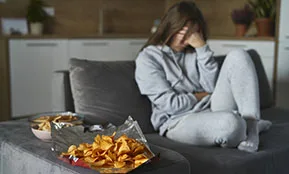

11 Sep, 2025

Full recovery is possible, and it begins when we understand no one chooses this battle.
In Puerto Rico, many children and teens are fighting a silent battle: a war against their reflection in the mirror, against an inner voice whispering they’re not enough. Eating disorders are not always visible, but their emotional, physical, and mental toll is devastating.
Both Dr. Stipes, Director of VIVA CLINIC, and nutritionist Lyzmar Cordero share over a decade of experience helping youth and families return to a healthy, free life.
Eating disorders (EDs) are complex conditions that severely impact eating behaviors and body perception. The most common are anorexia nervosa, bulimia nervosa, and binge eating disorder. According to the National Eating Disorders Association (NEDA), over 28 million Americans are affected—and many begin in childhood or adolescence.
“No one chooses to have an eating disorder,” emphasizes Dr. Stipes. “They choose to recover.”
This distinction matters. Eating disorders are real mental health diagnoses—not “phases” or “attention-seeking behaviors.”
EDs often develop as control mechanisms in chaotic environments, experiences of abuse, bullying, or social pressure. They manifest through overwhelming anxiety and preoccupation with food, body weight, and body image.
Importantly, eating disorders do not discriminate. They can affect anyone, regardless of gender, sexual orientation, age, or socioeconomic background. Dr. Stipes has seen cases in girls as young as nine, adults in their 50s, and a significant rise among adolescent boys.
As parents and caregivers, we often focus so much on academics that we miss subtle, yet important, changes in our children’s eating habits. Early detection can mean the difference between fast recovery and years of struggle.
“The obsession with controlling food intake or creating restrictive rules not backed by a licensed nutritionist is a key red flag,” says Lyzmar Cordero. These behaviors disrupt family dynamics and social life, crossing into dangerous territory.
Living with an ED is like being “in an abusive relationship with someone in your own mind,” Dr. Stipes explains. Food—a constant in daily life—becomes a source of anxiety, guilt, and obsessive thoughts.
These youth experience terrifying irrational thoughts, deep insecurity, doubt, and guilt. It’s not about “eating less” or having “willpower.” It’s an exhausting mental battle that affects every part of their lives.
Malnutrition has a direct and serious effect on development, says nutritionist Lyzmar Cordero, which makes early intervention especially vital for children and teens.

Children and teens are constantly online—and social media plays a major role in shaping eating disorders.
“The constant exposure to unrealistic beauty standards leads to body dissatisfaction and harmful comparisons,” says Dr. Stipes.
Extreme dieting, normalized by influencers without professional credentials, spreads misinformation and dangerous advice. However, there’s also a positive side: support groups, awareness campaigns, and recovery stories—like those shared by NEDA—help offer hope.
“Full and total recovery is real,” affirms Lyzmar Cordero. “Seek professional help as soon as possible.”
Treatment for eating disorders must differ from conventional nutrition. “No calorie counting or portion measuring,“ Lyzmar stresses—those methods are often part of the problem.
At VIVA CLINIC, Dr. Stipes and Lyzmar work as a team, constantly monitoring both emotional and physical health.
“We can immediately identify risks and take action together,“ they explain.
This clinical-nutritional alliance allows for individualized goals based on the patient’s malnutrition risk while healing the emotional triggers behind the disorder.
The ultimate goal: help patients eat freely and without guilt.
“Family plays a decisive role in the patient’s outcome,” stresses Dr. Stipes.
Outside of therapy, families support the day-to-day recovery process.
Sometimes, that means parents take over meal preparation based on the nutrition plan, easing the burden on the child’s mind and avoiding obsessive calorie tracking.
Family education is key—lack of information can unintentionally lead to comments or actions that hinder recovery.

The specialists created a workbook:
“Living the Life I Truly Desire: An Anorexia Recovery Workbook“, born from their desire to create ripple effects beyond one-on-one therapy.
It includes exercises, affirmations, and evidence-based techniques illustrated by recovering patients—building a unique bond between reader and survivor.
“Education is the foundation of prevention,” says Lyzmar.
Eating disorders remain a taboo, and harmful practices are often normalized.
Parents, teachers, and healthcare professionals must recognize red flags early. Timely intervention prevents the escalation of symptoms and reduces long-term complications.
Dr. Stipes offers a message to every young person reading this:
“You are not alone. People will understand what you’re going through. There is hope—and it’s real.”
“Look at those who have recovered. You can get through this. You deserve a full, free life.”
And for families: seeking specialized help is not failure—it’s love.
Eating disorder recovery requires professional, multidisciplinary support. In Puerto Rico, VIVA CLINIC offers programs designed specifically for these diagnoses.
If you or someone you love shows these signs, remember: every day without help is a day further from healing.
Hope is real. Recovery is possible. A full life is waiting.
At Fields of Joy Foundation, we believe every young person deserves a life free from the tyranny of food-related obsessive thoughts. Your recovery story could be the one that inspires someone else.